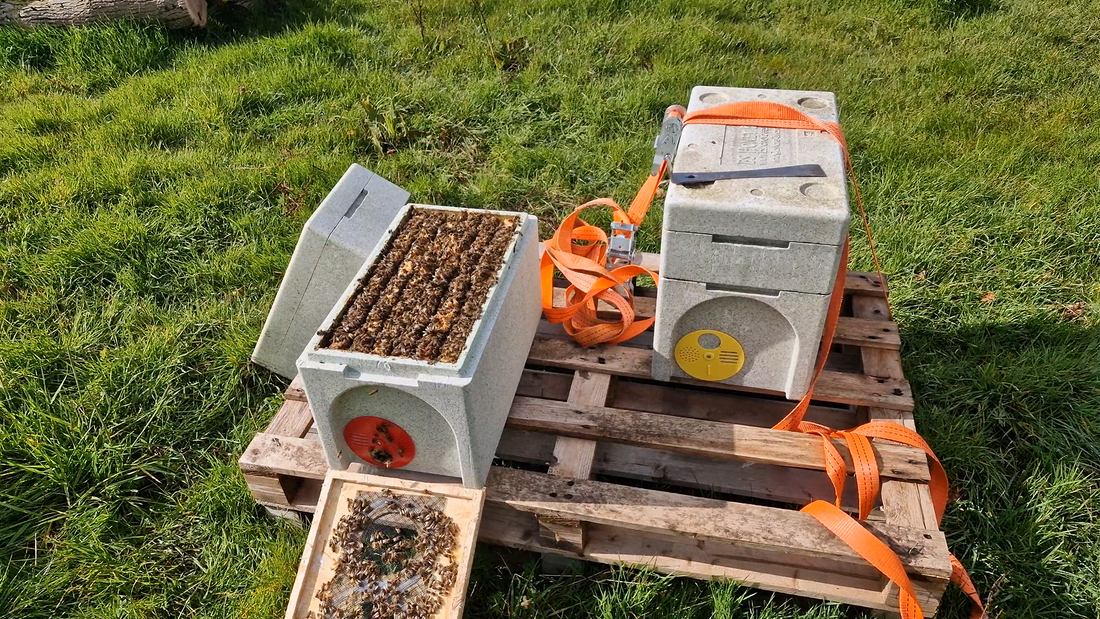Introduction to Beekeeping and Nucleus Colonies
Beekeeping is an enriching and rewarding pursuit, one that requires patience, dedication, and a keen willingness to learn about the fascinating world of bees. In the United Kingdom, the journey into beekeeping often begins with the acquisition of a nucleus colony, more affectionately known as a "nuc." This initial step is crucial for novices and seasoned beekeepers alike, offering a foundation from which a thriving hive can develop.
A nucleus colony is essentially a mini-hive with its own queen, workers, and brood, designed to kickstart the establishment of a new hive. Choosing between an overwintered nuc, which has been strengthened and survived the winter months, versus a spring nuc, newer and initiated in the warmer months, is one of the first decisions a budding beekeeper must make. Each option has its benefits: overwintered nucs are typically more robust and ready to expand come spring, while spring nucs, although younger, offer a fresh start in beekeeping season with potentially less upfront investment.
In the UK, the landscape and climate play significant roles in the beekeeping experience. The variability in weather, especially, affects the timing and management of nucs. Understanding these nuances is essential for ensuring the health and productivity of your bees. From purchasing your first nucleus to transitioning to a full-sized hive, each step is a learning curve that promises not only challenges but also the sweet reward of raw, natural honey and the satisfaction of contributing to bee conservation.
As we delve into the world of beekeeping, starting with the right nucleus colony sets the stage for a fulfilling journey. This guide aims to walk you through each step of this journey, ensuring your beekeeping adventure in the UK begins on a solid foundation.
Purchasing Your Nucleus Colony
The first step on your beekeeping journey is selecting and securing a nucleus colony. In the UK, the decision between opting for an overwintered nuc, with its established resilience and readiness for early productivity, versus a spring nuc, which may require nurturing through its inaugural season, is pivotal. This choice frames the initial phase of your beekeeping experience.
Understanding Your Options: Overwintered vs. Spring Nucs
Overwintered nucs are highly sought after for their demonstrated survivability through the winter and their potential to contribute to a honey crop in the year of purchase. Given their popularity and limited availability, it's wise to place orders early, ideally toward the end of the preceding year. Spring nucs, though more readily available, offer a different set of advantages, primarily for those looking to start fresh in the beekeeping season.
The Benefits of Buying Local
Choosing a local nucleus not only supports adaptation to the regional climate but also strengthens community ties within the beekeeping world. Local bees are better suited to the environment, enhancing their chances of thriving. This choice also supports local beekeepers and minimises the risk of disease transmission.
Collection vs. Postal Delivery
Whether you're collecting your nuc directly for a hands-on inspection or opting for the convenience of postal delivery, understanding your acquisition method is crucial. Some beekeepers may prefer the direct connection of collecting their bees, which also offers the opportunity to speak with the supplier. Postal delivery, facilitated by services like Royal Mail, provides an alternative for those who cannot collect, ensuring the bees are safely and carefully transported to their new home.

The Importance of Communication with Your Beekeeper
Engaging with your beekeeper, either before the purchase or at collection, can be incredibly insightful. This conversation can provide essential care tips, the colony's health history, and sometimes, the opportunity to secure an overwintered nuc even when they appear sold out. Beekeepers are a wealth of knowledge and often eager to share advice and experiences.
Where to Buy Your Nuc
It’s crucial to source your nuc from a reputable supplier, such as BS Honey Bees, known for their quality offerings. Factors to consider include the health of the bees, the beekeeper's reputation, and the support available after your purchase.
Making the Purchase
Ordering your nucleus is a commitment to beginning your beekeeping journey. For those interested in overwintered nucs, early ordering is essential due to their high demand and limited supply. Spring nucs, while more available, still require careful selection and timely ordering.
Preparing for Transportation
The safe transportation of your nuc, whether personally collected or delivered, is vital for the wellbeing of your new colony. Ensuring proper ventilation, secure placement, and a minimised journey are key considerations for their transition to a new home.
Securing the right nucleus colony is the foundation of a successful beekeeping venture. By taking these steps into consideration, you're well on your way to an enriching experience with your new bee companions.
Transporting Your Nuc Home Safely
The journey of bringing your nucleus colony home is a critical step that should be undertaken with careful planning and consideration for the bees' safety and comfort. Here’s how to ensure that your new bees are transported effectively:
Pre-Transport Preparations
Reaching out to the seller before transport can provide you with valuable insights into their pre-transport preparations and what you might need to do or bring, including a spray bottle for longer journeys. Protecting your vehicle's interior with a sheet or towel is advisable to catch any drips from pre-transport sugar syrup spraying, which calms the bees, provides nourishment, and helps keep them cool.
Ensuring Secure and Ventilated Transport
It's crucial to securely place the nuc in your vehicle, ensuring the entrance is taped shut for security while maintaining airflow. This often includes a wooden top with a ventilated mesh screen, essential for the bees' ventilation needs. Arranging the nuc so that it can be easily monitored during the journey is also recommended.
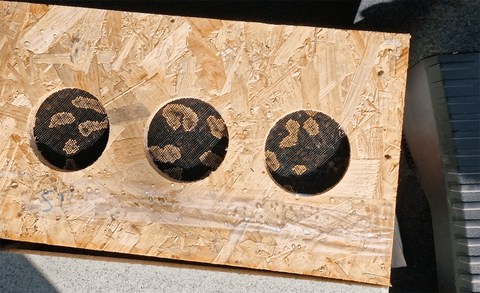
Temperature Control and Comfort
Driving with the nuc on the passenger seat, the windows slightly open, and the air conditioning on can create an ideal temperature environment for the bees. While this may result in a cooler ride for the driver, it's essential for keeping the bees comfortable, especially on warmer days.
Wearing a Bee Suit for Safety
Though it's generally not a problem, there's always a small risk of bees escaping from the nuc during transport. Wearing a bee suit or at least having one readily accessible in the car can be a prudent precaution. Driving in a bee suit may seem unconventional, but it ensures you're prepared should any bees find their way out.
Dialogue with Your Beekeeper
A conversation with your beekeeper at collection time can be incredibly beneficial. They can offer tailored advice for the journey home and the optimal timeline for transitioning the bees from the nuc to their new hive. Beekeepers are often keen to share their knowledge, helping ensure the best start for your colony.
Arrival and Immediate Care
Upon arrival, placing the nuc in a quiet area allows the bees to acclimatise to their new surroundings. After giving them some time to settle, the tape can be carefully removed from the entrances, encouraging the bees to explore their new environment. Monitoring the colony closely in the subsequent days is critical to their successful transition.
Taking these comprehensive steps ensures the safe transportation of your nucleus colony. With careful preparation, including the option of wearing a bee suit for added safety, you'll provide your new bees with the best possible introduction to their new home.
Establishing Your Nuc in Its New Location
Successfully introducing your nucleus colony to its new environment is a cornerstone of beekeeping success.

Choosing a Secure and Suitable Site
The ideal location for your hive is critical for both the bees' productivity and their safety. Select a site that is not publicly visible to help prevent theft, which is unfortunately not uncommon. Additionally, it's wise to position the hive away from the house to reduce the chance of bees entering living spaces. The chosen spot should be relatively flat, quiet, sheltered from extreme weather, and offer ample foraging options.
Preparing the Hive Site
Prior to moving the bees, ensure the site is ready. Setting up a hive stand will keep the hive elevated, guarding against dampness and predators. If you opt to fence around the hive, remember to leave enough space for your beekeeping tasks. A fence can encourage bees to fly upwards when exiting the hive, reducing their flight path into garden areas.
Wearing Protective Gear
Always wear a bee suit during the initial setup and when releasing the bees into their new home. This ensures your safety by minimising the risk of stings during these close interactions.
Transitioning the Bees to Their New Home
Allow the bees to acclimatise to the nuc at their new location for a brief period before moving them to a full-sized hive. Consult with the seller for specific advice on the timing of this transition and whether feeding is advised. Typically, some nucleus colonies may be ready to move after just a day, but seller guidance can provide crucial insights tailored to your bees.
Feeding the Colony
If recommended, supplementing the bees' diet with sugar syrup can help them establish themselves in the new location. Ensure any feeding apparatus is properly secured.
Orientation Flights
When bees venture out for the first time, they perform orientation flights to familiarise themselves with their surroundings. This behaviour, characterised by flying in front of the hive in noticeable patterns, is a good sign of the bees adjusting to their new home.
Final Placement
Once the hive is positioned, it's best not to move it further. Bees are remarkably navigational but relocating the hive after they’ve acclimatised can cause confusion and disrupt the colony's adaptation process.
By thoughtfully selecting and preparing your hive's location, you set the stage for a thriving beekeeping experience. This foundational work ensures a smooth transition for your nucleus colony and a prosperous start in their new environment.
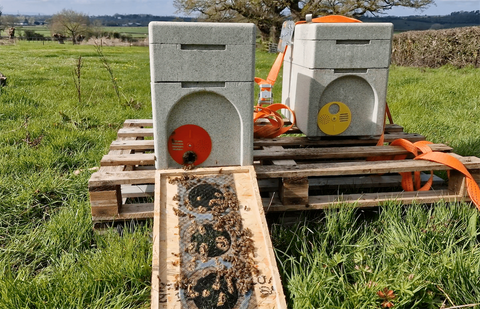
Transitioning from Nucleus to Full-Sized Hive
Moving your bees from the nucleus box to their permanent full-sized hive is a pivotal moment in your beekeeping journey. It's essential to approach this transition with care to ensure the colony's continued health and growth.
Timing and Precaution
Wait until the bees have had a few days to acclimate to their new surroundings before planning the move. When it's time, approach the process with patience and attention. Remember, after placing the colony into the full-sized hive, it's best not to disturb them for at least a week to allow them to settle in without stress.
Preparing the Full-Sized Hive
Ensure the full-sized hive is ready and situated in the same location as the nucleus to maintain orientation for the returning foragers. The hive should be clean, with frames prepared for the bees to expand their brood and honey stores.
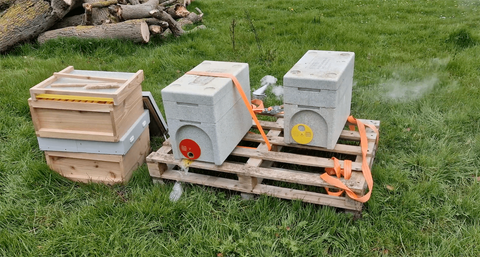
Careful Transition of Frames
When transferring the frames:
- Gently Remove the Nuc Lid: Be cautious as the frames may be propolised to the lid. A gentle approach prevents damage to the colony structure.
- Look for the Queen: As you transfer the frames, keep an eye out for the queen to ensure she safely moves to the new hive.
- Transfer Frames in Order: Maintain the same order to preserve the integrity of the brood pattern and minimise stress on the colony.
- Settle Remaining Bees: After moving the frames, tip the empty nucleus box over the hive and give it a swift tap to dislodge any remaining bees into their new home. Leave the nuc near the hive entrance to allow any stragglers to rejoin the colony.
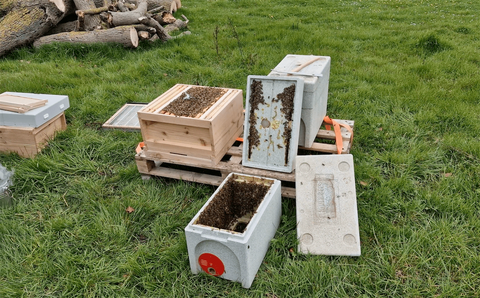
After the Move
Position the new hive exactly where the nuc was, aligning the entrances to ensure foragers can find their way back. The familiarity of the location eases the transition for the bees and supports their orientation flights.
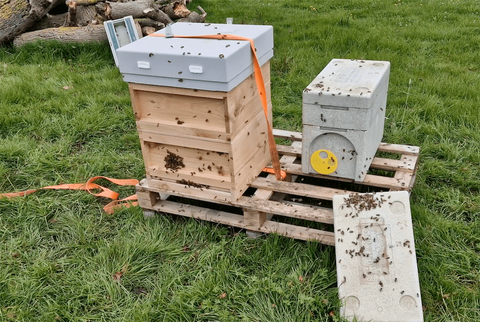
Monitoring Post-Transition
In the week following the transition, minimise disturbances to the hive to let the bees establish themselves. After this initial period, regular weekly checks are recommended to monitor the colony's health, queen productivity, and signs of potential swarming. These checks are crucial for early identification of issues that could impact the colony's development.
Ongoing Support and Feeding
Based on the local forage and time of year, you may need to continue supporting the colony with sugar syrup feedings to ensure their growth and vitality in the new hive. Feeding should be done with care to avoid attracting pests or causing undue stress to the bees.
Seeking Expertise
Throughout this transition and as your beekeeping experience grows, don't hesitate to seek advice from local beekeeping communities. Their insights can be invaluable in navigating the nuances of colony management, especially regarding swarming tendencies and hive health.
By carefully managing the transition from the nucleus to the full-sized hive, you're setting your colony up for success. This careful attention to detail ensures a smooth adjustment period for the bees and lays a strong foundation for a healthy, thriving hive.
Conclusion: Embarking on Your Beekeeping Journey
Embarking on the journey of beekeeping begins with a step filled with anticipation and excitement. From selecting your first nucleus colony to establishing it in its new home, each phase offers unique challenges and rewards. As we've explored, the transition from a nucleus to a full-sized hive is a pivotal moment that sets the stage for a thriving bee community. By carefully selecting your nuc, ensuring safe transportation, and providing a conducive environment for your bees, you lay down the foundation for a successful beekeeping experience.
Remember, patience and continuous learning are your best tools as you navigate through your beekeeping journey. Regular monitoring and engagement with the beekeeping community can greatly enhance your experience and the health of your hive. Whether you're checking for the queen's productivity, ensuring the colony is well-fed, or preparing for the colony's expansion, your attentiveness and care make all the difference.
As you grow in your beekeeping journey, remember that each challenge is an opportunity to learn and each success, a moment to celebrate. The world of beekeeping is not just about harvesting honey; it's about contributing to the health of the environment, supporting pollination, and joining a community of like-minded individuals passionate about these remarkable creatures.
We encourage you to take the plunge, equipped with the knowledge and insights shared here, and start your own beekeeping adventure. The bees await, ready to welcome you into their world with buzzes of productivity and the sweet reward of honey.

